How to Grow Macadamia: From Seed to Harvest – A Complete Guide
- March 28, 2024
- 18 comment
Discover how to grow macadamia, the tree celebrated for its buttery nuts, originally from Australia and now a prized crop in subtropical areas. Beyond their delicious taste, macadamia nuts offer valuable nutrients. This guide offers detailed steps for gardeners in suitable climates to cultivate macadamia trees, highlighting the patience and conditions needed for success.
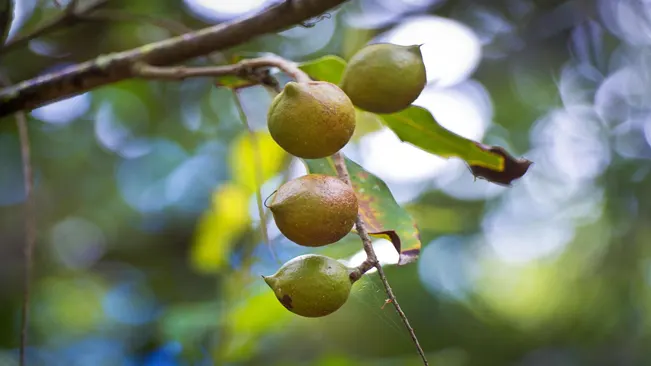
Macadamia Benefits
| Benefit | Description |
|---|---|
| Nutritional Value | High in healthy fats, protein, vitamins, and minerals, including vitamin A, iron, B vitamins, manganese, and folate. |
| Heart Health | Rich in monounsaturated fats, which can help reduce cholesterol levels and lower the risk of heart disease. |
| Antioxidant Properties | Contain antioxidants like flavonoids, which combat free radical damage and reduce oxidative stress. |
| Brain Health | Omega-9 fatty acids in macadamia nuts may support brain health and enhance cognitive function. |
| Weight Management | High in fiber and healthy fats, they can promote satiety and help in managing weight. |
| Skin Health | The essential fatty acids and vitamins in macadamia nuts can contribute to healthy, glowing skin. |
| Bone Health | A good source of phosphorus, magnesium, and calcium, which are essential for bone and teeth health. |
| Digestive Health | Fiber in macadamia nuts aids in digestion and can help prevent constipation. |
| Anti-inflammatory Properties | The omega-3 fatty acids present can have anti-inflammatory effects. |
| Reduced Diabetes Risk | Their low sugar and carbohydrate content, combined with high fiber, may help in managing diabetes. |
List on How To Grow Macadamia
- Choosing the Right Variety
- Location and Climate
- Planting Your Macadamia Tree
- Watering and Mulching
- Nutrition and Fertilization
- Pruning and Maintenance
- Pest and Disease Management
- Harvesting
Choosing the Right Variety
Macadamia trees come in various types, with the most common being Macadamia integrifolia and Macadamia tetraphylla. The former thrives in warmer, subtropical climates, while the latter is more tolerant of cooler temperatures. Research local varieties and select one that suits your region’s climate and soil conditions.
Macadamia integrifolia
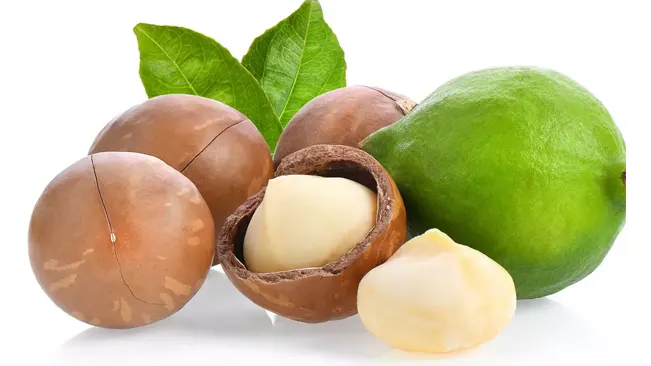
- Climate Preference: This variety prefers warmer, subtropical climates. It’s best suited for areas where temperatures don’t often drop below freezing.
- Nut Characteristics: The nuts of Macadamia integrifolia are known for their smooth shells and high-quality oil content. They are often considered superior in flavor and texture.
- Growth Habits: This species tends to have a more upright growth habit, making it slightly easier to manage in terms of space and harvesting.
- Geographical Popularity: It’s commonly grown in commercial productions in regions like Hawaii, which offer ideal growing conditions for this variety.
Macadamia tetraphylla
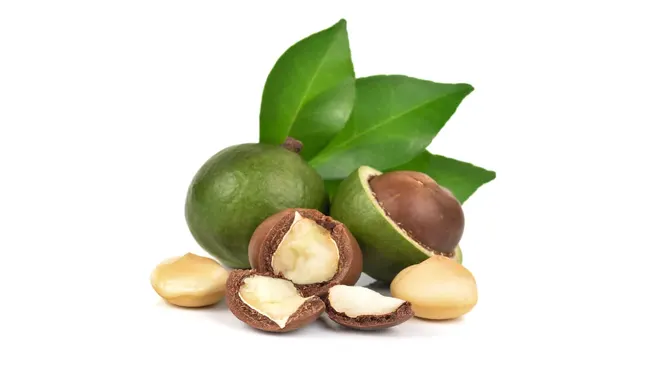
- Climate Preference: More adaptable to a broader range of temperatures, including cooler conditions. It can tolerate slightly lower temperatures compared to Macadamia integrifolia.
- Nut Characteristics: The nuts have a rougher shell and are slightly smaller. They are still highly valued for their taste and nutritional content.
- Growth Habits: This species tends to spread wider and may require more space. Its broader canopy can provide more shade, which can be beneficial in certain garden layouts.
- Geographical Popularity: It’s often found in areas with a more variable climate, including certain regions in Australia and South Africa.
Factors to Consider When Choosing
- Local Climate: Assess the typical temperature ranges and frost occurrences in your area.
- Soil Type: Both varieties prefer well-drained, fertile soils. However, Macadamia tetraphylla might be slightly more tolerant of less ideal soil conditions.
- Space Availability: Consider the growth habits of each type in relation to the space you have available.
- Purpose: If you’re growing for personal consumption, either variety is great. For commercial purposes, Macadamia integrifolia is often preferred due to its higher market demand.
Hybrid Varieties
- In some regions, hybrid varieties that combine traits of both Macadamia integrifolia and Macadamia tetraphylla are available. These hybrids can offer improved cold tolerance, disease resistance, and sometimes, increased productivity.
Location and Climate
Macadamia trees prefer a climate with ample rainfall, well-drained soils, and protection from strong winds. They thrive in subtropical regions with mild, frost-free winters and warm, humid summers. Ideal temperatures range from 60°F to 85°F.
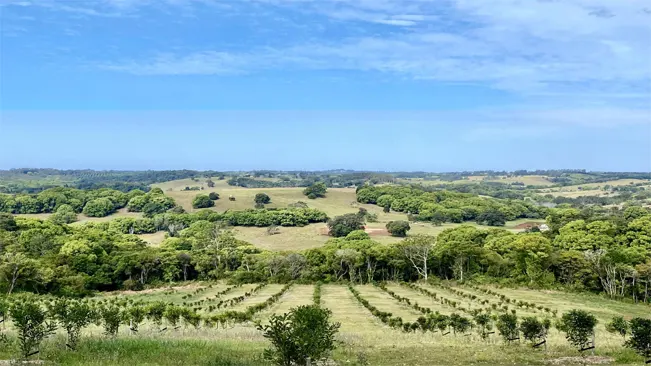
Location Considerations
- Topography: Macadamia trees flourish in varied topographies but are often found in gently sloping areas. This ensures good drainage, which is crucial for their health.
- Soil Type: The ideal soil for macadamia is deep, rich, and well-drained, with good aeration. They can tolerate a range of soil types, from volcanic loams to sandy soils, as long as waterlogging is not an issue.
- Altitude: Macadamias are commonly grown at altitudes from sea level up to 2,500 feet. The altitude can affect the temperature and humidity, which in turn influences the growth rate and nut quality.
- Proximity to Water Sources: While macadamias need a good supply of water, they don’t tolerate standing water. Proximity to a water source for irrigation is beneficial, especially in areas where rainfall is less predictable.
Climate Requirements
- Temperature: Macadamias grow best in temperatures ranging from 60°F to 85°F. They are sensitive to extreme cold and frost, which can damage the trees and reduce yields. Young trees are particularly susceptible to frost damage.
- Rainfall: These trees require ample rainfall, ideally between 40 and 60 inches per year, spread evenly. In areas with less rainfall, supplemental irrigation is essential, particularly during the flowering and nut development stages.
- Humidity: Macadamia trees do well in humid conditions, typical of many subtropical environments. High humidity supports the growth of the foliage and the development of the nuts.
- Wind Protection: While they can withstand some wind, macadamias benefit from protection against strong winds. Windbreaks or planting in sheltered locations can prevent physical damage to the trees and loss of nuts.
Planting Your Macadamia Tree
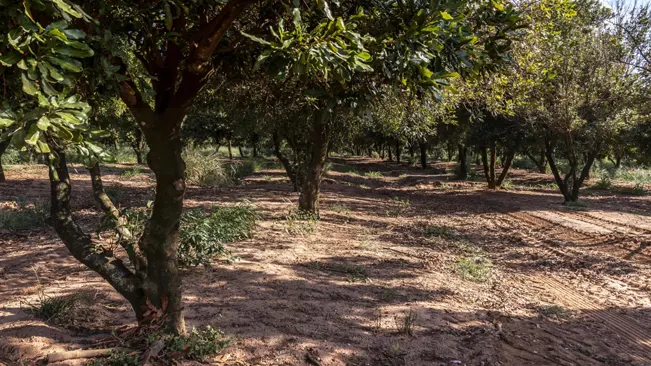
- Soil Preparation
- Deep, Well-Drained Soil: Macadamia trees have deep root systems, so they flourish in soils that allow roots to penetrate deeply without obstruction. Good drainage is crucial to prevent waterlogging, which can lead to root rot.
- Rich in Organic Matter: Incorporating organic matter like compost or well-rotted manure into the soil improves its fertility and structure, thereby providing the nutrients the tree needs to grow.
- Soil pH Testing: It’s important to test the soil’s pH before planting. Macadamias prefer a slightly acidic to neutral pH. If your soil is too alkaline or too acidic, you may need to amend it. For instance, applying sulfur can lower the pH, while lime can raise it.
- Spacing
- Room for Growth: Spacing is key for healthy growth and nut production. Trees should be spaced at least 20 feet apart. This spacing accommodates their wide spread and ensures that each tree gets enough sunlight and air circulation.
- Consider Future Growth: Remember, macadamia trees can live for many years and grow quite large. Planning with their mature size in mind helps prevent overcrowding and reduces the need for future pruning or re-planting.
- Planting
- Depth Consistency: Plant the trees at the same depth they were growing in the nursery. Planting too deep can stress the tree and slow its growth, while planting too shallow can expose roots and destabilize the tree.
- Watering After Planting: Thorough watering right after planting is crucial. It helps settle the soil around the roots and ensures that the roots have enough moisture to start establishing themselves.
- Mulching: After planting, applying a layer of mulch around the base of the tree (but not touching the trunk) can help retain soil moisture and regulate temperature. Mulch also suppresses weed growth which can compete with the young tree for nutrients and water.
- Additional Tips
- Planting Time: The best time to plant macadamia trees is during the late winter or early spring, allowing the tree to establish itself during the growing season.
- Staking: In windy areas, staking young trees can provide support and prevent root damage.
Watering and Mulching
Regular watering is crucial, especially during the tree’s first few years and in dry periods. Avoid waterlogging as it can lead to root rot. Mulching helps retain moisture and control weeds, but keep the mulch away from the trunk to prevent rot.
Watering Macadamia Trees
- Initial Years: In the first few years after planting, macadamia trees are establishing their root systems. During this period, consistent watering is vital. It helps the roots to grow deep and strong, which is crucial for the tree’s long-term health and productivity.
- Frequency and Amount: The amount and frequency of watering will depend on your local climate and soil conditions. Generally, deep watering once or twice a week is recommended. However, in very hot or dry conditions, more frequent watering may be necessary.
- Monitoring Soil Moisture: It’s important to check the soil moisture regularly. The goal is to keep the soil moist but not waterlogged. Overwatering can lead to root rot, a serious issue that can damage or kill the tree. A good rule of thumb is to water when the top 2-3 inches of soil become dry.
- Drip Irrigation: Using a drip irrigation system can be an efficient way to water your macadamia trees. It delivers water directly to the roots, minimizing wastage and reducing the risk of fungal diseases that can occur with overhead watering.
Mulching Macadamia Trees
- Benefits of Mulching: Mulching is the practice of placing a layer of material (like wood chips, straw, or compost) on the soil surface around the tree. It helps in retaining soil moisture, reducing water evaporation, controlling weed growth, and maintaining a stable soil temperature.
- Proper Application: When applying mulch, keep it a few inches away from the trunk of the tree. This space prevents excess moisture buildup around the trunk, which can cause rot or fungal infections.
- Depth of Mulch: A layer of 2-4 inches of mulch is generally adequate. Too much mulch can suffocate the roots, while too little may not effectively retain moisture or suppress weeds.
- Choosing Mulch: Organic mulches are preferable as they break down over time, adding nutrients to the soil. Avoid using materials that are too fine or dense, as they can form a crust that impedes water infiltration.
- Regular Maintenance: Replenish the mulch as needed, usually once or twice a year, to maintain its effectiveness. This also helps to add fresh organic matter to the soil as the old mulch decomposes.
Nutrition and Fertilization
Feed macadamia trees with a balanced fertilizer. They benefit from nutrients like nitrogen, potassium, and phosphorus. Apply fertilizer several times a year, more frequently in the growing seasons.
Understanding the Nutritional Needs of Macadamia Trees
Macadamia trees, like many fruit-bearing trees, have specific nutritional requirements to ensure healthy growth and optimal nut production.
- Nitrogen (N): Essential for leaf growth and overall vigor of the tree. Nitrogen supports the development of foliage, which is vital for photosynthesis and, consequently, for the tree’s energy production.
- Phosphorus (P): Important for root development and flower formation. Phosphorus supports the tree’s ability to use and store energy, playing a crucial role during flowering and fruiting.
- Potassium (K): Aids in flower and fruit quality, and overall health of the tree. Potassium is vital for various plant processes, including water uptake, enzyme activation, and photosynthesis.
Types of Fertilizers for Macadamia Trees
When choosing fertilizers, it’s important to select a balanced formulation that caters to these nutritional needs. There are several types of fertilizers suitable for macadamia trees
- Complete Fertilizers: These contain a balanced blend of N, P, and K. They are typically labeled with three numbers representing the percentage of each nutrient (e.g., 10-10-10).
- Slow-Release Fertilizers: These gradually release nutrients over time, reducing the risk of over-fertilization and providing a steady nutrient supply.
- Organic Options: Organic fertilizers like compost or well-rotted manure can be beneficial, offering a wide range of nutrients and improving soil structure.
Fertilization Schedule and Application
The timing and frequency of fertilizer application are crucial
- Initial Fertilization: After planting, fertilize young trees to encourage good root and foliage development.
- Regular Feeding: Fertilize several times a year, particularly during the growing seasons (spring and summer). The frequency can be adjusted based on the tree’s growth rate, soil fertility, and the type of fertilizer used.
- Reduced Winter Fertilization: Lower the amount or frequency during the winter months when the tree’s growth typically slows down.
- Application Method: Apply fertilizer evenly around the drip line of the tree, which is the area directly under the outer circumference of the tree canopy. This placement ensures the nutrients reach the roots effectively.
Pruning and Maintenance
Prune young trees to encourage a strong, open canopy, which aids in nut production and health. Remove dead or diseased branches regularly.

Pruning
- Objectives
- Formative Pruning: In the early years, pruning helps in shaping the tree and establishing a strong structural framework. This involves selecting and maintaining a central leader (the main upright stem) and well-spaced lateral branches.
- Productivity: Proper pruning increases sunlight penetration and air circulation within the canopy, which is essential for nut development and reducing disease incidence.
- Maintenance: Regular pruning keeps the tree manageable and facilitates harvesting.
- When to Prune
- The best time to prune is in late winter or early spring, just before the new growth starts. This timing helps the tree to heal quickly and reduces the risk of disease.
- How to Prune
- Start by removing any dead, damaged, or diseased wood.
- Thin out crowded branches to ensure good air circulation.
- Cut back branches that cross or rub against each other, as this can cause wounds and entry points for disease.
- For young trees, prune to shape the tree and establish a good branch structure. Avoid heavy pruning as this can stress the tree.
- Tools and Techniques
- Use sharp and clean pruning tools to make clean cuts. This helps in faster healing of the wounds.
- Make cuts at a slight angle, away from the bud or branch, to prevent water accumulation on the cut surface.
Maintenance
- Regular Inspection:
- Regularly check the tree for signs of pests or diseases. Early detection is key to effective management.
- Mulching:
- Apply a layer of organic mulch around the base of the tree to retain soil moisture, regulate temperature, and suppress weeds.
- Watering:
- Ensure consistent watering, especially during dry periods. However, avoid over-watering to prevent root rot.
- Fertilization:
- Apply appropriate fertilizers based on soil tests to ensure the tree gets the necessary nutrients.
- Pest and Disease Control:
- Implement appropriate pest and disease control measures. It could be organic methods or chemical treatments, depending on the severity and type of problem.
- Soil Care:
- Regularly test the soil to monitor pH and nutrient levels. Adjust the soil conditions as needed to maintain a healthy growing environment.
Pest and Disease Management
Be vigilant about pests like macadamia nut borers and diseases such as husk rot. Use appropriate organic or chemical treatments as needed.
Pests
- Macadamia Nut Borer
- Description: This pest is a larva that bores into the nut, causing direct damage to the kernel.
- Management: Use pheromone traps for early detection. Biological control agents, like certain wasps, can be effective. Chemical insecticides may be used, but timing is critical to target the larvae before they enter the nut.
- Other Pests
- Mites, scale insects, and thrips can also affect macadamia trees.
- Regular monitoring and application of horticultural oils or specific pesticides can control these pests.
Diseases
- Husk Rot
- Description: A fungal disease that causes the husk to rot, which can subsequently affect the quality of the nut.
- Management: Good orchard hygiene is crucial. Remove and destroy affected nuts and debris from under trees. Fungicide sprays can be effective, especially during periods of high humidity.
- Other Diseases
- Root Rot: Caused by poor drainage, leading to fungal growth. Ensure good soil drainage and consider fungicides if necessary.
- Stem Blight: This is a fungal disease causing lesions on branches. Prune infected areas and apply appropriate fungicides.
Integrated Pest and Disease Management (IPDM)
- IPDM Approach: Combining cultural, biological, and chemical control methods to manage pests and diseases effectively and sustainably.
- Cultural Practices: Include proper spacing, pruning, and sanitation to reduce pest and disease incidence.
- Biological Control: Utilize natural predators or parasites to control pest populations.
- Chemical Control: When necessary, use selective pesticides and fungicides, applying them responsibly to minimize environmental impact.
Harvesting
Macadamia trees can take 7-10 years to begin producing nuts. Harvest when the nuts fall to the ground, usually between late fall and spring. Dry the nuts before cracking the hard outer shell to reveal the edible kernel.
Timing and Indicators of Harvest Readiness
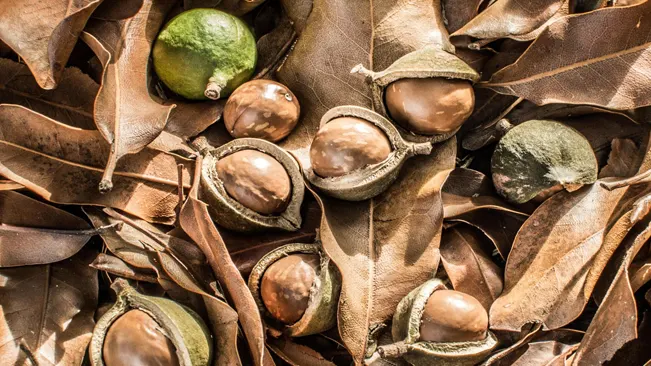
- Age of Bearing: As mentioned, macadamia trees start bearing nuts typically between 7-10 years after planting. Some grafted varieties may begin producing earlier.
- Seasonal Harvesting: The nuts usually mature and are ready for harvest between late fall and spring. The exact timing can vary depending on the geographic location and climatic conditions.
- Visual Indicators: Mature macadamia nuts will fall from the tree naturally. This natural drop is a key indicator that the nuts are ready for harvest. The outer husk changes from green to brown as they ripen.
Harvesting Method
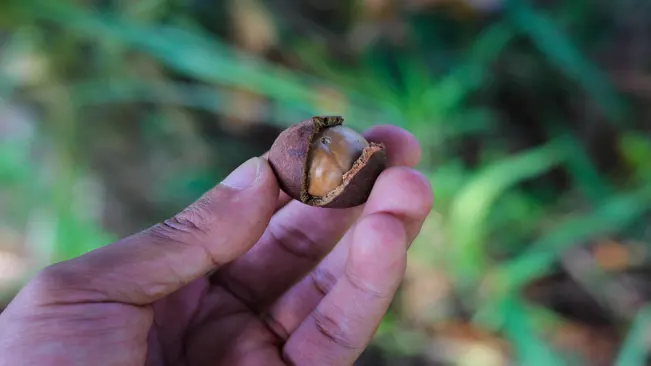
- Manual Collection: Collect fallen nuts from the ground. It’s advisable to harvest frequently, as leaving nuts on the ground for too long can lead to quality degradation or loss from pests and rodents.
- Using a Nut Harvester: For larger orchards, a mechanical nut harvester can be used. These devices roll over the ground, picking up nuts without the need for bending and manual collection.
Post-Harvest Processing

- De-husking: If the outer husk hasn’t already separated from the nut, remove it. This is often done immediately after harvesting to prevent husk rot and other quality issues.
- Drying: Proper drying is crucial. The nuts should be dried to reduce their moisture content, which helps in long-term storage and eases the process of cracking the hard shell.
- Method: Drying can be done by laying the nuts out in a sunny, dry area or using a nut dryer.
- Duration: This process can take several days to a few weeks, depending on the method and environmental conditions.
- Indicator of Dryness: The nuts are adequately dried when the kernels rattle inside the shell.
Cracking the Nut
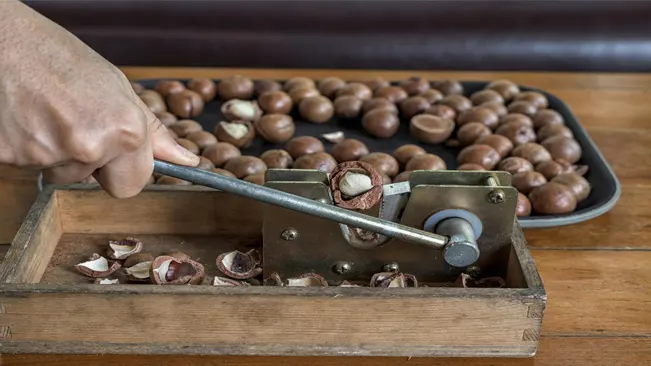
- Hard Shell: Macadamia nuts are renowned for their extremely hard shell. Special macadamia nut crackers are often used, as regular nutcrackers may not be sufficient.
- Technique: Apply even pressure to avoid crushing the kernel inside.
Storage
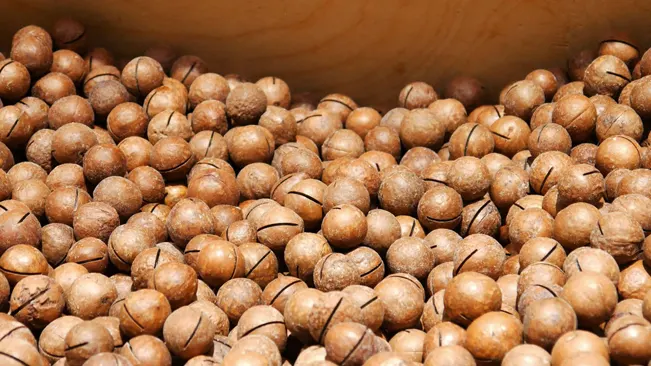
- Shell-On: Nuts stored in their shells have a longer shelf life and can be kept for several months in a cool, dry place.
- Shelled Nuts: Once cracked, the kernels should be stored in an airtight container and can be refrigerated to extend freshness.
Quality and Yield
- Factors Affecting Yield: The yield and quality of macadamia nuts can be influenced by tree age, climatic conditions, soil health, and pest management practices.
- Economic Value: Due to their long maturation period and the labor-intensive harvest process, macadamia nuts are considered a premium product in the market.
Related Post:
- How to Grow Mulberry
- How to Grow Horseradish
- How to Grow Daikon Radish
- How to Grow Zucchini
- How to Grow Oregano
Conclusion
Growing macadamia trees is a rewarding journey that requires patience and attentive care. These trees thrive in subtropical climates and demand well-drained soils, regular watering, and proper nutrition to flourish. While it takes several years for the trees to start bearing nuts, the wait yields a bountiful and nutritious harvest. By understanding and respecting their natural growing conditions and requirements, gardeners can successfully cultivate these valuable and delicious nuts.
FAQs (Frequently Asked Questions)
- What climate is best for growing macadamia trees?
Macadamia trees thrive in subtropical climates. They prefer a temperature range of 60°F to 85°F, with mild, frost-free winters and warm, humid summers. - How much space do macadamia trees need?
Macadamia trees can grow quite large, so they should be spaced at least 20 feet apart to ensure adequate room for growth and air circulation. - How long does it take for a macadamia tree to start producing nuts?
It typically takes a macadamia tree about 7-10 years to start bearing fruit. However, this can vary depending on the variety and growing conditions. - What kind of soil is suitable for macadamia trees?
Macadamia trees prefer deep, well-drained soil that is rich in organic matter. A slightly acidic to neutral pH (5.5 to 7) is ideal. - How often should I water my macadamia tree?
Regular watering is important, especially during the tree’s first few years and in periods of dry weather. However, avoid over-watering as this can lead to root rot. - Do macadamia trees need fertilization?
Yes, macadamia trees benefit from balanced fertilization. They require nutrients like nitrogen, potassium, and phosphorus, especially during their growing seasons. - Is pruning necessary for macadamia trees?
Yes, pruning young trees is important to develop a strong, open canopy, which aids in nut production and overall tree health. Regularly remove dead or diseased branches. - How do I protect my macadamia trees from pests and diseases?
Regularly inspect your trees for signs of pests, such as the macadamia nut borer, and diseases like husk rot. Use appropriate organic or chemical treatments as needed. - When and how do I harvest macadamia nuts?
Macadamia nuts are typically ready to harvest when they fall to the ground, usually between late fall and spring. After collecting, dry the nuts before cracking the hard outer shell to access the edible kernel. - Can I grow a macadamia tree from a nut?
While it’s possible to grow a macadamia tree from a nut, it’s generally more reliable to plant grafted seedlings. Trees grown from nuts may not inherit the parent tree’s qualities and can take longer to produce nuts.

Kristine Moore
Forestry AuthorI'm Kristine Moore, a seasoned garden landscaping professional with over 30 years of experience. My extensive career has been dedicated to transforming outdoor spaces into stunning, sustainable landscapes. With a deep understanding of horticulture, design principles, and environmental stewardship, I have become a respected figure in the field, known for creating harmonious, visually appealing, and eco-friendly gardens. My commitment to excellence and continuous learning in landscaping trends and techniques has solidified my reputation as an expert in garden design and implementation.
18 comments
We live in Hawaii, and have a mac tree in our backyard. For years we have been harvesting the nuts and we've had the tree trimmed a few times over the years. Now this year, the nuts are tiny when they are falling. I see no disease or anything on the tree. We have had a lot of rain for the last couple of years. Can you possible tell me what's wrong ? Thank you!
ALICE
April 19, 2024 12:57 amI would like to start Macadamia nuts farming business but I don't know where or how to find land and funding. I'm based in Durban. Please help anyone
Thul
April 4, 2024 6:53 amWhere to get macadamia seedlings to plant into my farm?
Moeketsi Edward Ntamane
April 3, 2024 5:33 pmGreat question! To find macadamia seedlings, I recommend checking with local nurseries or garden centers, especially those specializing in subtropical plants. You can also explore agricultural supply stores or online retailers that offer a variety of tree seedlings. Sometimes, local farmers' markets or gardening groups can be excellent resources for finding specific plants like macadamia. If you're looking for a particular variety, reaching out to a regional agricultural extension service or a macadamia growers' association could provide valuable leads. Happy planting!
Kristine Moore
April 4, 2024 12:28 amHi I got plenty of farming space. All I need is the know-how t plant those macadamia trees and how, where to tet them. I also need cherry trees too!
Moeketsi Edward Ntamane
April 3, 2024 5:10 pmHi! It's great to hear about your farming space. For macadamia trees, focus on well-drained soil, ample sunlight, and protection from strong winds. Start with local nurseries for seedlings and look for Macadamia integrifolia or Macadamia tetraphylla, depending on your climate. For cherries, consider your climate's compatibility with sweet or sour cherry varieties. Local agricultural extension services can offer tailored advice and may help source quality seedlings. Don't forget to test your soil to ensure it meets the needs of these trees. Best of luck with your planting!"
Kristine Moore
April 4, 2024 12:32 amI am interested in starting a macadamia farm. I live in Northern Uganda. Where can I get the seeds or seedlings from?
ONYABO ONONO ISAIAS
April 3, 2024 11:06 amFor starting your macadamia farm in Northern Uganda, I recommend reaching out to local agricultural extension offices or universities with agricultural programs. They often have resources or can direct you to reputable nurseries or seed suppliers in your area. Additionally, connecting with existing macadamia farmers or agricultural cooperatives could provide insights on where to obtain quality seeds or seedlings. It’s crucial to source from reliable suppliers to ensure the health and genetic quality of your plants. Best of luck with your macadamia farming venture!
Kristine Moore
April 4, 2024 12:36 am1.Specify how market trend (country) and urgent( buyer) in Tanzania 2. Availability of industry tools and processing procedures. 3.send me PDF full doc. To my email.
KIBAMBI IBRAHIM
April 3, 2024 7:37 amI am venturing into horticulture business, I need to know what fruits to grow on my 5 acre land.
Lhaba
April 2, 2024 12:59 pmStarting a horticulture business on 5 acres requires choosing fruits that match your climate, soil, and market demand. Warm areas suit citrus and avocados, while temperate zones are good for apples and berries. Ensure you have reliable water and consider the maintenance needs of each fruit. Diversifying your crops can reduce risks and stabilize income. Success depends on effective cultivation practices, and local agricultural services can provide essential guidance.
Kristine Moore
April 4, 2024 12:41 amI stay in hammanskraal ihave 2 trees of macademia i want to know my trees will have fruits. Temperature around here is around 31 to 34 during summer
lucky motileng
April 2, 2024 6:34 amVery interested in planing macaddemis trees. Request contacts for reliable expect who can provide me with distinctive guide with financial projections step by step per Hector. This will include installing driping system
Bekinkosi Johan Nkuna
April 2, 2024 5:47 amHi I want to buy a macadamia farm , what should i look at the farm before i buy it?
Wiseman Ngema
April 2, 2024 12:51 amThank you. I would like information on how to grow and harvest Olive trees also.
Sonwabo Ngcingwana
April 1, 2024 10:53 amKeep guiding us
Okilan Joseph Patrick
April 1, 2024 9:34 amChicken manure directly apply macadamia farms is good or bad? Please give me the advice for that your information is good and well experience observations Thank you









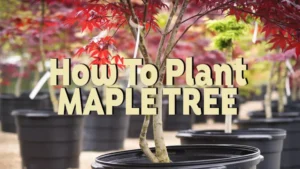



Chicken manure apply in macadamia farms is good or bad ? What's about insects damage
Badarudheen Tharayil peedikayil
April 29, 2024 6:07 pm